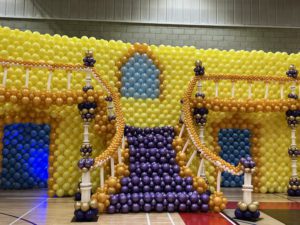Are your balloons Eco-Friendly?
With the focus on the environment on peoples minds and rightly so I am often asked are your balloons ‘ eco-friendly’
The answer to that is yes and no. It depends on the type of balloon used in your decorations.
The majority of my designs use 100% biodegradable latex balloons.
Rubber or latex balloons are made from the sap of the rubber plant, hevea brasiliensis. Latex is 100% biodegradable. The rubber plant is a tropical tree native to South America and now cultivated throughout the world.
Rubber is extracted by collecting the sap from a live tree, which produces latex for approximately 25 years. A single rubber tree can offset 1 million metric tonnes of carbon dioxide during its economic lifespan.
In addition, a latex balloon biodegrade at the same rate as an oak leaf so you can’t get much more eco-friendly than that!
Types of Balloons
Balloons are classified according to the material they are made of. Today, most balloons are made of rubber or mylar. Rubber or latex balloons are made from the sap of the rubber plant, hevea brasiliensis. Latex is 100% biodegradable. The rubber plant is a tropical tree native to South America and now cultivated throughout the world.
Rubber is extracted by collecting the sap from a live tree, which produces latex for approximately 25 years. A single rubber tree can offset 1 million metric tonnes of carbon dioxide during its economic lifespan.
Mylar balloons, also known as foil balloons, are made from a polyester resin coated with a metallic foil for a decorative effect. These balloons, however, are not biodegradable.
Both latex and mylar balloons can be inflated with air or helium gas. As we know, helium allows a balloon to rise into the air and because mylar is very thin and lightweight, it keeps its buoyancy for a long time, sometimes several weeks. As balloon professionals, we do not encourage the release of foil balloons into the air for both safety and environmental reasons.
The Properties of Latex Balloons
When latex balloons filled with helium are released into the air, the gas expands, allowing them to soar as high as 28,000 feet above the earth. At this elevation, the air temperature is minus 40.5 degrees C. The balloons freeze and shatter into small pieces that fall back to earth. If a balloon does not burst, it’s carried in the prevailing wind until conditions allow it to descend.
How Latex Breaks Down
Exposure to water, sunlight and soil cause latex to break down at approximately the same rate as an oak tree leaf and faster than a piece of wood. The process of decomposition starts at the time the balloon is made.
After a latex balloon is inflated, it develops a patina, which is the oxidation of the latex. After a balloon pops or deflates, it degrades just like any other organic substance. The rate of decomposition depends on the conditions of exposure.
A controlled study demonstrated that under most conditions, latex balloon pieces are almost completely degraded in about six weeks. This only applies to the actual balloons anything that is attached to the balloon may not be for example string or ribbon is not.
How do we use Balloons?
We use 2 other types of balloons in our decorations, Mylar or Foil balloons and Deco Bubbles which are made of a plastic material. Whilst these are not biodegradable they can be refilled time and time again so are recyclable.
If you bring your foil or deco bubble back to me then I will gladly refill them for you at a nominal charge.
I hope I have answered your questions but I am happy to discuss the type of balloon best suited to your event at my workshop. Just give me a call to arrange an appointment 01709 789333.





